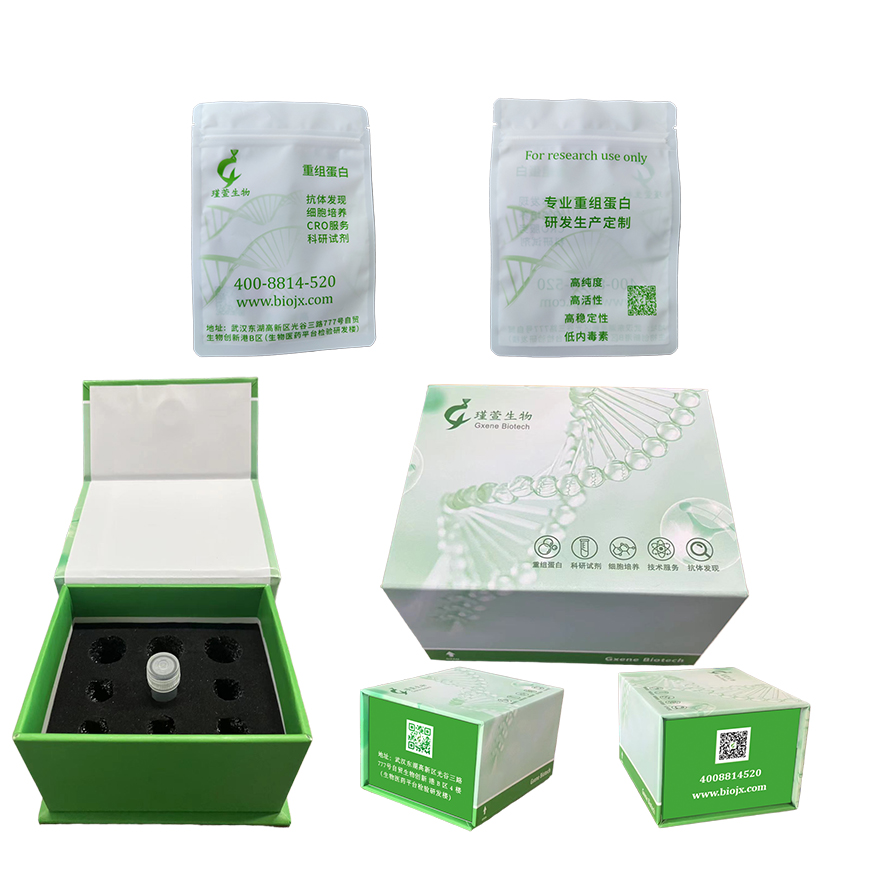种属
Human
表达宿主
HEK293 cells
描述
Recombinant Human CD72 Protein is produced by HEK293 cells expression system. The target protein is expressed with sequence (Arg117-Asp359) of human CD72 (Accession #NP_001773.1) fused with a hFc tag at the C-terminus.
标签
C-hFc
纯度
> 95% by SDS-PAGE.
内毒素
<1EU/μg
制剂
Lyophilized from a 0.22 μm filtered solution of PBS, pH 7.4.
储存
Store the lyophilized protein at -20°C to -80°C for 12 months.
After reconstitution, the protein solution is stable at -20°C for 3 months, at 2-8°C for up to 1 week.未开盖的干粉蛋白在 -20°C至-80°C可保存12个月;
复溶之后,蛋白溶液在-20°C及以下可保存3个月,在2-8℃可保存1周。
After reconstitution, the protein solution is stable at -20°C for 3 months, at 2-8°C for up to 1 week.未开盖的干粉蛋白在 -20°C至-80°C可保存12个月;
复溶之后,蛋白溶液在-20°C及以下可保存3个月,在2-8℃可保存1周。
复溶
Centrifuge the vial before opening. Reconstitute to a concentration of 0.1-0.5 mg/mL in sterile distilled water. Avoid votex or vigorously pipetting the protein. For long term storage, it is recommended to add a carrier protein or stablizer (e.g. 0.1% BSA, 5% HSA, 10% FBS or 5% Trehalose), and aliquot the reconstituted protein solution to minimize free-thaw cycles.收到重组蛋白产品之后请检查蛋白冻干粉末是否贴于瓶底,如果粉末浮起,开盖之前请先低温离心。将蛋白用说明书中指定的缓冲液复溶至0.1-0.5 mg/mL(请注意蛋白复溶浓度不能低于0.1 mg/mL),室温平衡5-10 min保证充分溶解,复溶过程中请不要剧烈涡旋及吹打蛋白溶液。如需长期储存,建议复溶时添加载体蛋白或者稳定剂(如0.1% BSA, 5% HSA, 10% FBS 或者 5% 海藻糖),同时将复溶后的蛋白溶液按照需求进行分装,储存于-20°C至-80°C,随取随用,避免反复冻融。
研发方向
CD72 成为 B 细胞增殖和分化协调的关键参与者。作为具有二硫键的同二聚体,它与 CD5 形成关联,从而在 B 细胞环境中形成复杂的信号网络。此外,CD72 与蛋白质酪氨酸磷酸酶 PTPN6/SHP-1 发生相互作用,特别是酪氨酸磷酸化,表明它通过复杂的基于磷酸化的调节机制参与调节细胞反应。这凸显了 CD72 在 B 细胞功能和信号传导动态景观中的多方面作用。
背景信息
B-Cell Differentiation Antigen CD72 (CD72) is a single-pass type II membrane protein. CD72 exists as a disulfide-linked homodimer and contains one C-type lectin domain. CD72 is expressed on B lineage cells, NK cells, monocytes, dendritic cells, and mast cells. CD72 is a ligand for CD5. CD72 associates with CD5, interacts with PTPN6/SHP-1 and plays a role in B-cell proliferation and differentiation. CD72 associates with CD79A in the B cell antigen receptor (BCR) complex following antigen stimulation and dampens BCR signaling through interactions with the phosphatase SHP-1.

